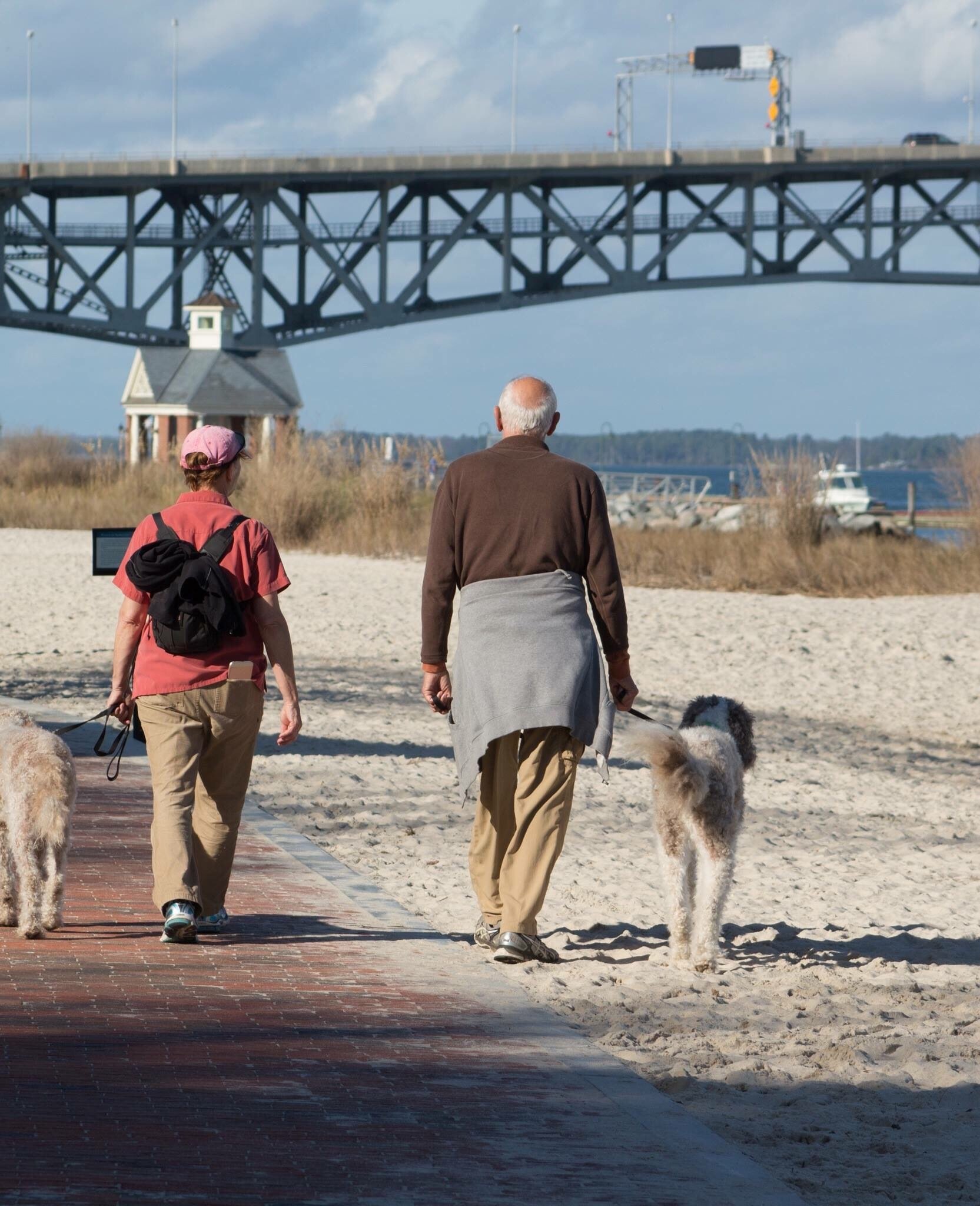How walking can save your life: A guide for senior and caregiver well-being
by Katie Wright | Nov 02, 2021 | PhysicalHealth, family support, benefits of walking | 0 Comments

My senior and caregiver friends, I want to tell you some things about walking.
About why it’s one of the most important things in my life.
It’s right up there with love, family, friends, and well-being. When I’m struggling with any of these other important things, walking helps me sort them out.
It’s the topic of this article because I have a goal in mind - that after reading more, you’ll be convinced of something I’ve believed for a long time. Walking will add life to your years, and that makes it a lifesaver. It’s good for your body, and it’s even better for your brain and your sense of well-being.
When it comes to walking we’re very fortunate to be in the Pacific Northwest. It’s very beautiful here. Parks and walking trails abound, and it’s easy to find welcoming neighborhood areas with sidewalks. With few exceptions, our weather year-round allows us to get outside, provided we’re prepared for a few months of chilly temperatures and a little drizzle.
Walking is also one of the easiest activities to do. The only gear you need is a pair of good shoes and outerwear suitable for the weather. It can be done just about anywhere and anytime. It doesn’t require special skills, and it’s adaptable to both group and solo outings.
If you’re mobile but sedentary, start walking. If you’re already a walker, do more of it. If you’re a caregiver for someone who uses a wheelchair, getting outside for daily walks and fresh air will be extremely beneficial for both of you.
There’s plenty of evidence to confirm walking as a lifesaver.
And there’s this little Latin phrase – solvitur ambulando. It is solved by walking.
I’m thoroughly convinced of the wisdom of this term, so much so that it’s been my favorite mantra for the past few years. Ever since I started regularly walking every single day, I can attest to its truth.
Walking can save your life.
Who says walking can save your life?
Walking has been studied for years. It’s a form of exercise particularly well-suited to older adults.
Let’s start with pieces of research on the physical benefits of walking. Each link below directs you to one of the many studies on each topic.
According to a piece in Harvard Health Publishing, former Centers for Disease Control and Prevention Director Thomas Frieden said walking is “the closest thing we have to a wonder drug.” The article goes on to cite several reasons for the claim.
Walking can help you resist sugary snacks and may help you avoid weight gain. Research from the University of Innsbruck revealed that brisk walking can curb the urge to eat sugary snacks. A Harvard study looked at the genes that promote obesity and learned that people who walk for an hour a day realize fewer weight-related effects from those genes.
Walking can help your immune function. According to the Loyola University Health System, walking is a good way to reduce stress hormones, which in turn helps to lessen not only serious health conditions but also the intensity of colds and flu.
Walking can help to lessen joint pain. The Arthritis Foundation offers the Walk with Ease program to address arthritis joint pain. Other studies have supported the findings that walking actually provides joint protection, particularly for hips and knees, through lubrication and muscle development.
Walking can reduce the risk of developing breast cancer. Research by the American Cancer Society indicates that lots of walking – at least 7 hours per week – lowered the risk by 14% in some cases and up to 25% in the most active women.
Did you notice the information cited above indicates these physical health benefits are realized with lots of walking? Walking as much as every day for at least an hour? This might sound like a lot, but bear in mind this amount represents study results. It’s important to remember there’s also plenty of value in walking for shorter periods.
How walking affects older adults’ general well-being
Walking is good for your mental health. A fascinating study had two small groups of older adults agree to add a 15-minute walk each week to their usual routine. One group was told simply to walk outside if possible. The other group was told to walk in a new place and to “cultivate awe” while walking – or observe things in greater detail, with fresh eyes. The subjective results of these “awe walks” demonstrated that focusing on the outside world instead of themselves made participants feel happier and more connected.
It can improve your memory. Moderate exercise such as walking can affect the area of the brain responsible for memory. One study showed that the volume of the hippocampus increased by 2% in test subjects (ages 55-80) who participated in walking 40 minutes three times per week. Another study demonstrated that even in older people with early signs of memory loss, regular walking improved their cognitive scores by improving blood flow to their brains.
Walking outside helps your body synthesize vitamin D. Especially in the winter months when we’re less likely to be outside, planning a regular walking routine means more exposure to sunlight. Even on our Pacific Northwest cloudy days, you’ll still get some of the ultraviolet light your body needs to make Vitamin D, the nutrient that’s so important for bone health.
It can improve your brain health. A study on walking, dancing, and brain health found that aging adults who regularly walked briskly for six months renewed their brain’s white matter or wiring. This translated into improved cognitive functioning. Interestingly the participants who did dancing as an aerobic activity did not show as much improvement, although their levels of aerobic fitness were judged to be as good.
Walking makes you more creative. Behavioral scientists Marily Oppezzo and Daniel L. Schwartz (Stanford University) conducted four experiments to demonstrate that walking boosts creative ideation. Even short outings can produce this effect for walkers, and it works for those being pushed in a wheelchair as well. Being outside enhances it, in part due to “the increased perceptual stimulation of moving through an environment.” (Journal of Experimental Psychology: Learning, Memory, and Cognition 2014, Vol. 40, No.4)
It can help you learn to pay closer attention. Paying attention seems simple enough, but most of us don’t do enough of it. Would you start walking and paying more attention if you learned it could benefit your brain health? Paying closer attention helps the brain process new information, and as a result, helps it protect cognitive function. A walk outside requires you to be more observant, and if you focus on it, you’ll notice even more and realize greater benefits.
7 ways to enhance your walking experience
If going outside for a walk on a cold or damp day doesn’t appeal to you, here are some things to consider that might help.
You can start slowly. Even a little walking is better than being sedentary. If you haven’t done much walking, it’s best to ease into it. Try walking three times a week, and start by going for 15 or 20 minutes. If you set a regular time for your walk, it won’t take long for your body and mind to start relying on it. Form a habit for best results. Keeping track of your progress can be a confidence booster.
Plan to walk outside. Try not to let cold temperatures or showers deter you. With warm outerwear and the promise of a hot beverage and dry shoes when you return, an outing in less-than-perfect conditions offers something you just can’t get if you’re indoors – fresh air, a fresh perspective, and the feeling of accomplishment. (Do beware of walking on days when there are icy sidewalks and road surfaces, however.)
For variety, change your route. Keep things fresh and interesting by traveling different streets or driving to a walking trail if there’s one near you. Choosing different settings gives your mind a break from routine. If you’re in your own neighborhood, try finding things you haven’t noticed before – there’s always going to be something new to discover.
Get a good pair of walking shoes. Do a little research before you buy. A good fit is essential, but there are additional features you’ll want to consider for optimal comfort and safety. If possible, keep these shoes exclusively for your walking exercise to prolong their life. If you’re walking on a wet day, pull the insole out to help them dry when you return home.
Use a walking stick or trekking pole for stabilization. You’ll improve your balance and posture with this tool, which also helps to reduce muscle and joint stress. You may not need it for shorter outings or walks on even surfaces like pavement, but if you’re on a trail it can make you feel more stable on uneven or rocky surfaces. Use one or two.
Make most of your walks a time to find solitude and explore your thoughts. Walking can serve as a form of meditation or mindfulness in this way. Spending time outdoors alone with your thoughts can be soothing and energizing at the same time. It can facilitate your ability to focus and be more observant of your surroundings.
Occasionally make walking a time for other activities, such as:
- dog walking
- listening to a podcast
- photography
- bird watching
- geocaching
How to get the greatest benefit from walking
This is a simple recipe:
- walk more,
- walk briskly, and
- practice mindful walking by being truly aware of your surroundings.
Resources for more information on walking
Here are two book recommendations to guide you or delight you, or both. Both are available through the King County Library and Seattle Public Library.
Forest Bathing: How Trees Can Help You Find Health and Happiness by Dr. Qing Li. This book, with beautiful photographs of forests, helps you understand the Japanese practice of shinrin-yoku, or forest-bathing – walking and taking in the forest atmosphere.
Afoot and Lighthearted: A Journal for Mindful Walking by Bonnie Smith Whitehouse. If you’re like me, you’ll want to make the $15 investment and purchase your own copy of this amazing little book. It’s actually a guide for walking in journal format, with quotes and observations throughout. The author may well make you fall in love with walking.
And be sure to read SeaCare’s earlier blogs, which include information about good local walks:
- Easy walks in the Bellevue area for seniors and their caregivers
- Ideas for getting caregivers and seniors outside this National Park Month (July)
- How exercise improves mental health: 3 reasons for caregiver families to start moving
The SeaCare team wants to help caregiver families put more life into their years. Learn more about how we can support you and your loved ones.
Katie Wright writes about aging and senior wellness from Bellingham, WA. You can read more about her here.
If you or a loved one you know are looking for additional support during this time and are interested in scheduling a free in-home assessment, please contact SeaCare In-Home Care Services today! A SeaCare family member is standing by. 425-559-4339.



0 Comments